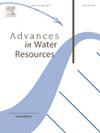Effects of temperature on the multi-scale characteristics of bioclogging in porous media
IF 4
2区 环境科学与生态学
Q1 WATER RESOURCES
引用次数: 0
Abstract
In this study, an improved multi-scale algorithm was developed to analyze the effects of temperature on the bioclogging processes at pore and Representative Elementary Volume (REV) scales. In this algorithm, Immersed Boundary-Lattice Boltzmann Method- Cellular Automata (IB-LBM-CA) model for pore-scale simulation and Discrete Unified Gas-Kinetic Scheme-Cellular Automata (DUGKS-CA) model for REV simulation were coupled with the porosity and permeability obtained at pore-scale simulation as connecting bridge. In this study, a biofilm detachment model with non-Newtonian shear-thinning characteristics was considered, and also the tendency of high nutrient concentration for microbes and the inoculation rates of microbes were taken into account. The simulation results had been validated by laboratory percolation experiments with a high consistence. The main results are as follows: (1) At the pore scale, as the temperature increased, the clogging time decreased, the proportion of the clogging time occupied by slow decline period decreased and the proportion of the clogging time taken by rapid decline period increased. (2) At the REV scale, the clogging time decreased with the increasing temperature and inoculation rate. The relationship between clogging time and inoculation rate could be described by an exponential decay model. (3) A linear relationship was found between the clogging time at the pore and REV scales, and the proportion coefficient decreased as the inoculation rate increased. The influences of inoculation rates and temperatures on the clogging time proportion coefficients could be described by exponential decay model and linear decay model, respectively. The average exponential decay rate of clogging time proportion coefficient for the inoculation rate is 0.54 / % and the linear decay rates of clogging time proportion coefficient for the temperature are mainly decreased with increasing inoculation rate.
温度对多孔介质中生物堵塞多尺度特征的影响
本文提出了一种改进的多尺度算法,用于分析温度对孔隙尺度和代表性基本体积(REV)尺度生物测井过程的影响。该算法将孔隙尺度模拟的浸入式边界-晶格玻尔兹曼法-元胞自动机(IB-LBM-CA)模型和REV模拟的离散统一气动力方案-元胞自动机(DUGKS-CA)模型与孔隙尺度模拟得到的孔隙度和渗透率作为连接桥梁。本研究考虑了具有非牛顿剪切变薄特征的生物膜脱离模型,并考虑了微生物的高营养浓度趋势和微生物的接种率。模拟结果在室内渗流实验中得到了验证,具有较高的一致性。主要结果如下:(1)在孔隙尺度上,随着温度的升高,堵塞时间减小,缓慢下降期堵塞时间所占比例减小,快速下降期堵塞时间所占比例增大。(2)在REV尺度下,随着温度和接种量的增加,堵塞时间缩短。堵塞时间与接种率之间的关系可以用指数衰减模型来描述。(3)孔隙堵塞时间与REV呈线性关系,比例系数随接种量的增加而减小。接种量和温度对堵塞时间比例系数的影响分别可以用指数衰减模型和线性衰减模型来描述。接种率的堵塞时间比例系数平均指数衰减率为0.54 / %,温度的堵塞时间比例系数线性衰减率主要随接种率的增加而降低。
本文章由计算机程序翻译,如有差异,请以英文原文为准。
求助全文
约1分钟内获得全文
求助全文
来源期刊

Advances in Water Resources
环境科学-水资源
CiteScore
9.40
自引率
6.40%
发文量
171
审稿时长
36 days
期刊介绍:
Advances in Water Resources provides a forum for the presentation of fundamental scientific advances in the understanding of water resources systems. The scope of Advances in Water Resources includes any combination of theoretical, computational, and experimental approaches used to advance fundamental understanding of surface or subsurface water resources systems or the interaction of these systems with the atmosphere, geosphere, biosphere, and human societies. Manuscripts involving case studies that do not attempt to reach broader conclusions, research on engineering design, applied hydraulics, or water quality and treatment, as well as applications of existing knowledge that do not advance fundamental understanding of hydrological processes, are not appropriate for Advances in Water Resources.
Examples of appropriate topical areas that will be considered include the following:
• Surface and subsurface hydrology
• Hydrometeorology
• Environmental fluid dynamics
• Ecohydrology and ecohydrodynamics
• Multiphase transport phenomena in porous media
• Fluid flow and species transport and reaction processes
 求助内容:
求助内容: 应助结果提醒方式:
应助结果提醒方式:


